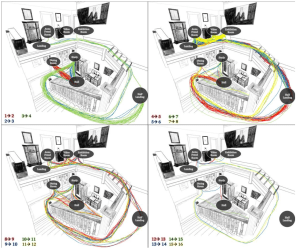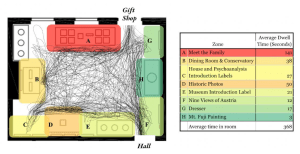Visitor Evaluation at the Freud Museum London
Project Introduction
The Freud Museum London (FML) is a heritage museum that preserves the final home of the founder of psychoanalysis, Sigmund Freud, and his daughter and fellow psychoanalyst, Anna Freud. The museum provides an informative look into how the Freud family lived and worked, but the museum is worried that the space is not effective enough at attracting and engaging visitors. This worry has grown in recent years due to the effects that the COVID-19 pandemic has had on museum visitation. United Kingdom (UK) museums have had to redirect their focus towards attracting the local community and appealing to a broader audience, which is especially difficult for heritage house museums with very specific focuses. Thus, the FML is currently looking for ways in which they can improve visitors’ experiences to increase visitor retention, community involvement, and the overall engagement of its guests.
The goals of this project were to evaluate visitor engagement, community involvement, and repeat visitation at the Freud Museum London. To achieve this goal, we established three objectives:
- Evaluate current and best practices in other museums and analyze how they encourage deeper engagement, repeat visitation, and community engagement;
- Assess visitor experiences and engagement at the Freud Museum London; and
- Assess community knowledge, awareness, and opinions about the Freud Museum London.
Methodology
To assess how other museums differed from the Freud Museum London, we visited several small historic house museums in the London Hampstead area and interviewed members of their staff. While we explored the museums, we noted the ways in which they engaged their audiences through displays and staff interactions. While at these other museums, we interviewed staff about the effectiveness of their displays, as well as the methods that the museums currently use to connect with the local community and encourage repeat visitation. We then compared these museums’ engagement with the strategies we noticed while first visiting the Freud Museum London. Additionally, we compared the responses from staff at other museums with those of the Freud Museum London staff regarding their interactions with the local community.
To evaluate how visitors engage with the Freud Museum London, the team conducted visitor observations within the museum, an exit survey, and a survey for current members. The visitor observations consisted of tracking guests as they moved through each room, noting how long they dwell at each exhibit. We conducted visitor observations in all eight of the museum rooms, and we conducted an additional observation study for the whole museum, in which we tracked the order in which visitors entered rooms throughout their visit. The survey was distributed via physical copies in the museum, as well as a digital version using a quick response (QR) code. In addition, the membership survey was sent out in the weekly update email for FML members.
The team measured community awareness and opinions of the Freud Museum London by conducting interviews with local school teachers and community leaders. These interviews discussed how the FML reaches out to the community, how the Freud Museum London could improve their outreach to the community, and which aspects of the museum would appeal to members of the local community that may not care about Freud or psychoanalysis.
Findings
We found many significant differences between the Freud Museum London and other small museums we visited. We noticed that these other museums had a significant number of interactive exhibits, and when asked about them, the museum staff members all claimed that they have had a positive effect on visitor engagement. It was also clear to the team that other historic house museums were making a more significant effort to engage the local community, either by collaborating with other local establishments on projects, or by including local community members directly into the museum by forums and displays. Additionally, the other museums utilized several creative accessibility workarounds such as purchasing a nearby building or offering virtual tours of the other floors on the ground level. Conversely, we also found that there were many factors that the Freud Museum London particularly excelled in when compared to other small historic home museums in the London Hampstead area, such as their membership program and their depth of information.
Our visitor observations revealed distinct patterns in how guests explore the museum. Most visitors move from the dining room to the Hall or Study and then return to the Study at the end of the visit. We also noticed that visitors tended to enter the Anna Freud Room before the Exhibition or Video Room, sometimes even skipping the Exhibition Room entirely (see Figure 1). However, we found that outside of these major patterns, visitors explored the museum in idiosyncratic ways, suggesting a lack of a clear direction and flow through the museum.
Figure 1: Typical pathways taken by visitors through the whole museum.
The individual room observations provided additional details about visitor flow. In each room, we noted how many visitors were attracted to each exhibit zone1, how long visitors remained engaged (i.e., dwell time) at each exhibit zone, which zones people skipped, and which paths visitors took through the rooms. We summarized these data pathways and dwell-time heat maps for each room. Figure 2 shows an example of one of these maps for the Dining Room. Figure 3 shows the numbers of visitors attracted to each exhibit zone and the nature of their engagement (i.e., reading, taking photographs, or engaged in discussion). Figures 2 and 3 show clearly that Zone A attracts most visitors and engages them for longer periods.
Figure 3: Total numbers of visitor engagements with zones in the Dining Room, including taking photographs, discussing the zone, reading displays, or skipping the zone entirely.
From the interviews with local community leaders, we found that the museum is generally perceived positively by local people and community groups. Nevertheless, the Museum is viewed as less accessible to the average person and as less engaged with local organizations, such as libraries, schools, and other museums. Despite the best efforts of the Museum to date, many individuals and organizations appear to feel that it remains aloof and is not an integral part of the community.
Recommendations
After collecting and analyzing our findings, the team concluded that the major areas in which the Freud Museum London could improve are:
- The way the space and layout engage visitors
- Their involvement of the local community
- Their ability to bring visitors back to the museum
- The accessibility of the house.
To improve the engagement of the space, we have recommended to the Freud Museum London that they introduce interactive exhibits, and other more flashy and initially attractive exhibits to the museum. These elements could aid the museum in engaging broader audiences, and inspiring visitors to learn more about Freud and psychoanalysis. It is important to note, however, that interactive and flashy displays can take away from the space if not implemented tastefully. To improve the museum flow and layout, we have recommended that the museum use these potential interactive and flashy displays as gateway objects that draw guests into the rooms and immerse them into the space. We also recommended that the museum adds center objects, either in the form of displays or seats, to direct people around the perimeter of the room and keep circulation patterns more consistent.
To increase their involvement with the local community, we have recommended to the Freud Museum London that they collaborate with local establishments on community projects, that they incorporate the local community into the museum through forums and opening the garden, and through offering concessions and other perquisites to local community members. These strategies would ideally improve the community perception of the FML and draw more local community members into the museum.
To encourage repeat visitation, we have recommended to the Freud Museum London that they should continue to push their membership option as much as possible. The museum is already garnering significantly more members than other museums of similar size, and promoting a membership program is an effective way to build a following of repeat visitors. The one change that the group feels would have a positive effect on repeat visitation is to hold more events. This is because the respondents to both the membership and exit survey stated that they would like to see more events, and that they would like to return to the museum for events.
To make the house more accessible, we have recommended to the Freud Museum London that they attempt to add a lift to the building. However, the team recognizes that this may not be possible due to the museum’s Grade 1 status. Thus, we have recommended that the museum incorporates some smaller, short-term accessibility options such as seating throughout the museum, and better lighting on the labels and displays.






